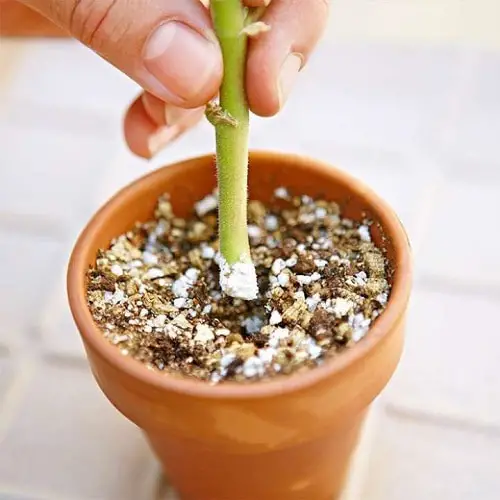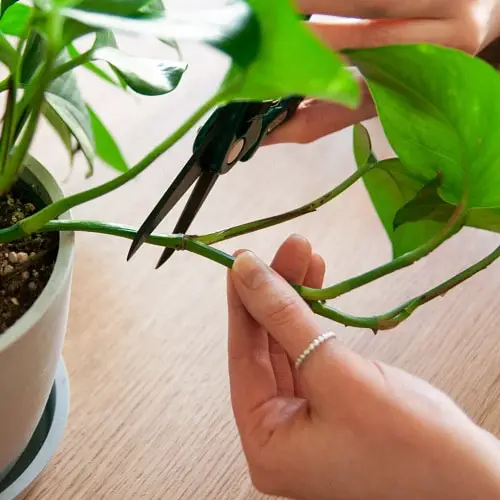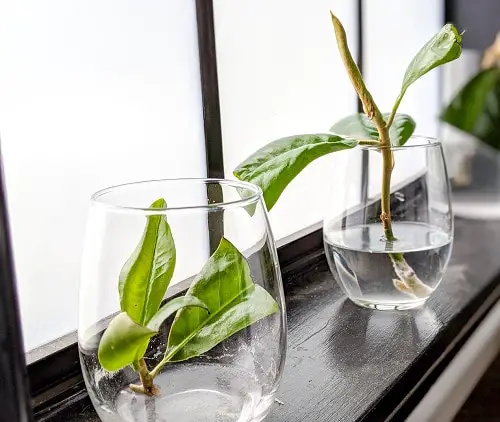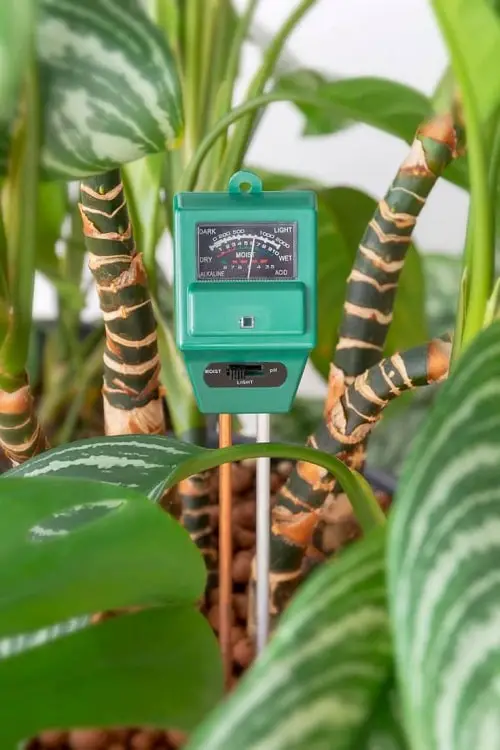Learn How to Root Indoor Plant Cuttings Easily and Quickly in simple steps and grow your houseplants effortlessly to make them thrive!
Here’s How to Root Indoor Plant Cuttings Easily and Quickly to multiply them without spending any additional money!
Have a look at the best houseplants you can grow from cuttings here
How to Root Indoor Plant Cuttings Easily and Quickly
1. Use Rooting Hormone

The rooting hormone helps in root formation and protects the plant from fungi and bacteria. It aids in root development at a fast pace and prevents transplant shock.
Aloe vera also works as a great rooting hormone for encouraging root development. Apart from that, you can also use apple cider vinegar, honey, and cinnamon.
We have a great article on homemade rooting hormones here
2. Remove the Lower Foliage
After taking the stem cutting, remove the lower leaves before propagation as decreasing the leaf surface eliminates the chances of water loss. Also, make sure that no lower leaves come in contact with the growing medium.
3. Prepare a Solution of Aspirin Water
To encourage root growth, make a rooting solution by crushing 4-5 aspirin tablets in a liter of water. Dip the ends of the cuttings before rooting them. You can also spray it on the cutting to prevent the chances of infection.
Aspirin contains an active ingredient known as salicylic acid. This acid enhances the immune response of plants, which helps them in combating pests and microbial attacks and prevents the formation of fungus leading to an increased growth rate.
Check out more aspirin benefits for the plants here
4. Make a Cut below the Node

The plant’s leaves and aerial roots grow from the nodes. For successful propagation, always take a stem cutting immediately below a node.
5. Use the Right Growing Medium
Soilless media helps in enhancing the initial root development by providing good aeration and drainage. You can use any soilless mix that is not nutrient-rich. Alternatively, try pure peat moss or cocopeat for propagation.
While growing the cuttings in water, make sure it’s free from chlorine. Always use fresh water and make sure that you change it once in 3-4 days. You can also use water from your aquarium.
Here’s how you can make your own potting mix at home!
6. Protect from Diseases
Diseases can affect your cuttings and cause wilting and dying. You can prevent it by following these measures:
- Utilize clean, sanitized, and dry tools.
- Take cuttings from a healthy plant.
- Make a clean cut at a 45-degree angle.
- Use a clean container and sterilized growing medium.
7. Provide the Ample Light Exposure

The cuttings require sufficient light for the right growth and development of roots. Place them at a spot that receives bright but indirect sunlight. Avoid keeping the cuttings in harsh sunlight as it will kill the plant.
A Tip: Exposure to direct morning sunlight will be beneficial.
8. Types of Cuttings
You can propagate the plants from herbaceous or softwood cuttings and hardwood cuttings. Softwood cuttings are the tender new growth of woody plants and you might have to take more care of them. However, your efforts will be paid as they root quickly.
Philodendron, Pothos, Wandering Jew, Prayer Plant, Begonia, Arrowhead Vine, and Chinese Money Plant are some of the best plants that grow from softwood cuttings easily.
Hardwood cuttings are taken from mature stems of the plant, usually the previous year’s growth. They are a lot firmer than softwood cuttings and do not bend easily. Fiddle Leaf Fig, Ti Plant, Dracaena, Dumb Cane, and Rubber Tree are some of the best plants to grow from hardwood or semi-hardwood cuttings.
Also, while propagating Succulents and cacti, it is important to let the cuttings heal, and form soft protective tissue known as a callus, for a better success rate. Apply the same rule while propagating Jade plant, Crown of thorns, and African violets too.
9. Temperature

You can improve the propagation success from cuttings by maintaining the temperature in the range of 65-85 F (18-30 C). The warm temperature helps in accelerating cell division in the cutting, which aids in faster callusing, initial root development, and subsequent root growth.



It gives me useful tips
It gives me tips how to root indoor play cuttings